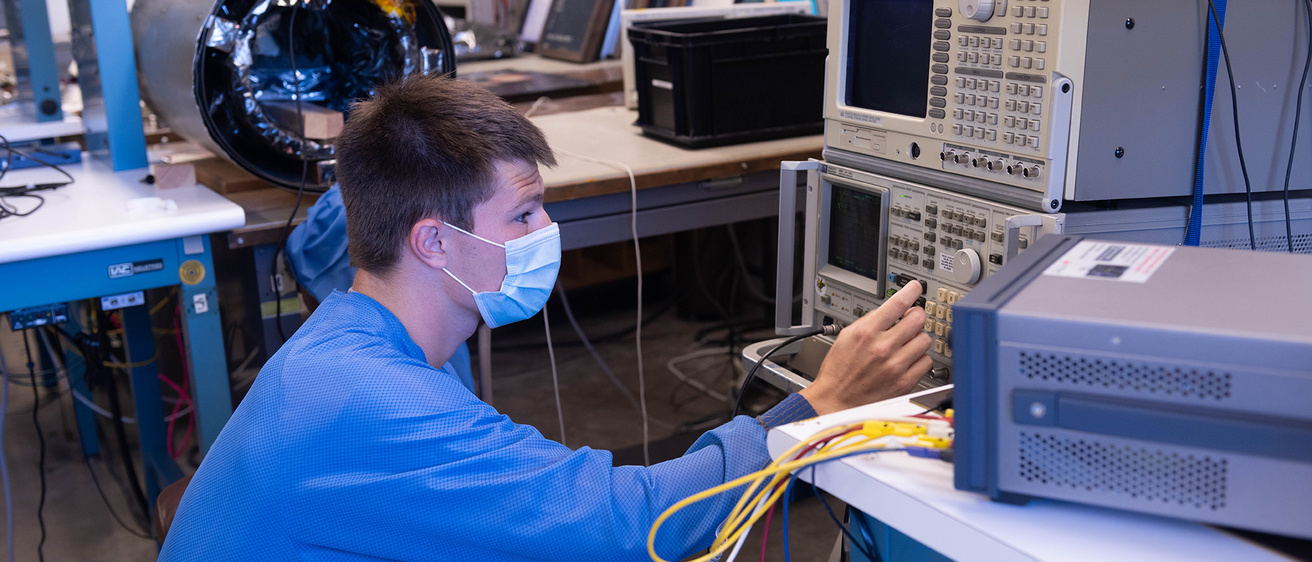Earlville native Andrew Carton never envisioned his opportunities could soar as high as working with NASA to help develop space-faring scientific instruments, but that’s exactly what he’s been doing for the past year at the University of Iowa.
Carton works out of the University as an electrical design engineer and as an assistant engineer on the NASA Tandem Reconnection and Cusp Electrodynamics Reconnaissance Satellites mission, or TRACERS. The project consists of scientific instruments that will fly on different satellites to measure a region of interest above the North Pole called the Cusp and detect different types of charged particles.
Carton said, “The instrument I’m an assistant engineer for is the magnetic search coil which detects changing magnetic fields. We also have a DC magnetometer which means “Direct Current” and senses the earth’s unchanging magnetic field, as well as an electric field instrument which measures electric potentials around the earth.”
According to Carton, he first realized his interest in physics and electronics at Beckman Catholic High School when he took a class that made him realize the potential jobs related to the creation of electronics.
“I can’t really say I was blown away and fascinated by this stuff from an early age,” he said. “A lot of my focus at an early age was sports. It wasn’t until halfway through high school at Beckman that I started taking some engineering classes and started to realize there were jobs out there to build this type of stuff. Before that I didn’t understand the career paths it would take to get to this point... I knew I had always been gifted in math and science just based on my test scores when I was in grade school, so I knew I could pretty much make whatever I wanted to do work based on my intellect. This is just what I applied myself toward after I realized what cool work engineering students get to work on.”
After graduating from Beckman, Carton attended the University of Iowa which, unknown to him at the time, had a strong history of work in spaceflight, having been the production site of America’s first successful satellite, Explorer 1, the second-ever man-made satellite to reach orbit after the Russian Sputnik 1.
While Carton initially planned to work with computers, he found himself more attracted to analog engineering and realized there were more job opportunities for it in the area than for digital work which would likely require him to move to Silicon Valley.
“When I first came to the university, my goal of what I wanted to work on when I got out of college was designing hardware that goes inside of computers,” he said. “That kind of transformed throughout course work, you just see what you like and don’t like. I started to gravitate away from the digital computer side of things and more towards your standard analog electrical engineering. I performed a lot better in those classes because I had a lot more interest in them, so it came a lot more naturally and didn’t seem like I had to force myself to work at it. That kind of coursework set me up for this job.”
Carton’s first glimpse into the university’s NASA work came from a class lecture by a professor who just so happened to be working on the TRACERS program.
“I was in a lecture and Craig Kletzing, who is the principal investigator of TRACERS, was my teacher at the time. He mentioned why the building was named Van Allen Hall. Van Allen was a professor who had made some pretty ground-breaking discoveries while he was at the University of Iowa. That was the first time I realized there was that type of research at the university.”
While he now knew this was work the university did, Carton later realized the opportunities he could take to become a part of it when he overheard a classmate named Suman Sherwani-now working at SpaceX- ask her adviser for guidance about which of two NASA internships to accept, with one option being at the University of Iowa itself.
“When I overheard Suman, it was something that, if I applied myself, I could potentiality become.”
Carton began his work at the university in November 2020 and said he’s quite happy with the progress he’s made in that year as he’s grown his opportunities by taking on extra responsibilities to alleviate his boss’s workload.
“I’m extremely happy,” he said. “I started with no professional experience other than IT which isn’t applicable to my work. To see where I am one year after when I came in and had no idea what I was getting myself into, I took everything in stride. The reason I’ve grown and learned so much is just because I’m constantly looking to help other people… I’m still trying to help and take on as many opportunities as I can.”
Since his work started, Carton has been added to two sounding rocket projects and a project which will investigate the Aurora Borealis in Alaska early next year.
Regarding the future, Carton said, “I definitely have some goals I want to hit. I would like to stay at the university and work on some other big projects we get, but I’m always open to new and bigger opportunities.”
by Daniel Charland, Dyersville Commercial
